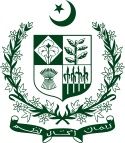 |
|---|
|
|
The Central Superior Services (CSS; or Civil Service) is a permanent elite civil service authority and the civil service that is responsible for running the bureaucratic operations and government secretariats and directorates of the Cabinet of Pakistan.[1] The Prime Minister is the final authority on all matters regarding the civil service.
The civil service defined itself as "key wheels on which the entire engine of the state has to move."[1] Derived from the colonial legacy of the former British Civil Service, the civil service came into its modern formation immediately after the establishment of Pakistan as a "Civil Service of Pakistan".[2] During its time of formation, the bureaucracy produced Ghulam Ishaq Khan who would go on to become the President of Pakistan. It influenced many of the state's defence, internal, foreign and financial policies.[3] In 1971, it was re-organized and reestablished under "Chapter I: Part-XII, Article 240" of the Constitution of Pakistan which gave it foundation and constitutional status.[4] The civil bureaucracy closely collaborated with the military establishments of Pakistani Armed Forces in issues concerning the national security.[2] The bureaucracy consists of 12 directorates that provide vital office and secretariat related duties to the Government of Pakistan.[5] The provincial bureaucracies are headed by the respective Chief Secretaries of Khyber Pakhtunkhwa, Sindh, Punjab and Balochistan. The highest attainable rank for an officer who serves in the country's bureaucracy is BPS-22 grade.

The Civil Service of Pakistan selects only 7.5% of the applicants by merit, education, qualification and experience. In comparison, 92.5% are selected by a quota system.[6] The civil service exams are competitive[1] and provides equal opportunities to males and females, depending on their qualifications. The CSS Examinations are held at the start of every year. The Federal Public Service Commission conducts and supervises the exams. CSS exams have a reputation for a very low pass percentage. In 2020, the passing percentage was only 1.962. In 2021, only 364 (2.11%) of the 17,240 participants cleared the multi-staged exam. In 2022, the passing percentage decreased to 1.85%.[7][8]
- ^ a b c Government Officials. "Civil Service of Pakistan". Government of Pakistan. Retrieved 5 September 2012.
- ^ a b Government of Pakistan. "District Management Group". District Management Group. Archived from the original on 1 May 2011. Retrieved 5 September 2012.
- ^ Author. "Journey of System". Geo Television Series (Educational Directorate). Geo Documentaries. Archived from the original on 19 December 2021. Retrieved 5 September 2012.
{{cite web}}:|last=has generic name (help) - ^ Constitution of Pakistan. "Part XII: Chapter 1: Services (Miscellaneous Article 240)". Constitution of Pakistan. Retrieved 5 September 2012.
- ^ CSS. "Directorates of Civil Services". Government of Pakistan. Archived from the original on 28 August 2012. Retrieved 5 September 2012.
- ^ "CSS Exam in Pakistan - All Information". smadent.com.
- ^ https://www.fpsc.gov.pk/sites/default/files/Final-Result-CSS-2022.pdf [bare URL PDF]
- ^ "CSS exam 2021: FPSC announces result for written part - Geo.tv". 30 September 2021. Retrieved 22 November 2021.

